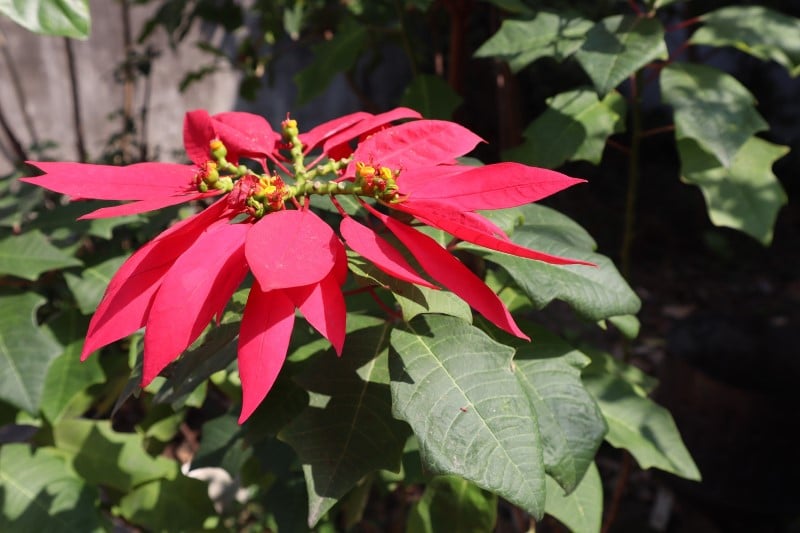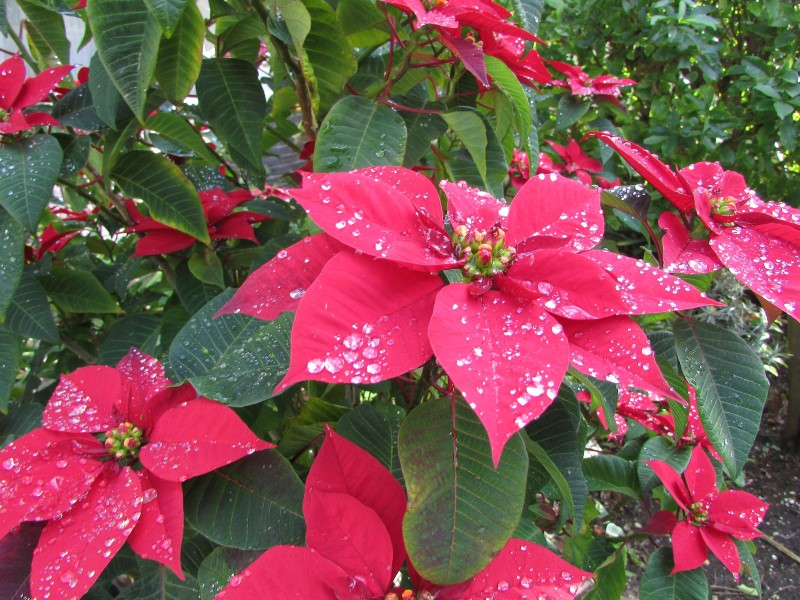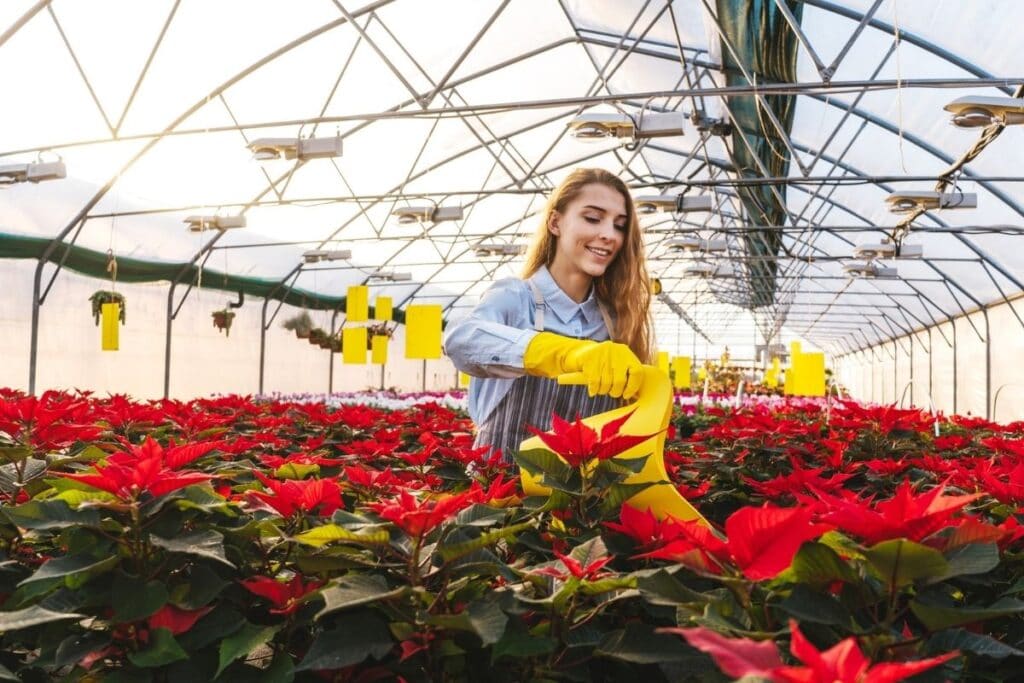Poinsettias are a festive and well-known plant for the winter holiday season. Learn how to grow and take care of this beautiful flowering plant in your own home or office.
Poinsettias are a popular Christmas decoration that is easy to grow. They come in many different varieties from red and white, to pink with green leaves. This makes them eye-catching for any holiday party or event.
You can also plant poinsettias indoors as they make great plants for the home during this time of year!
No matter how you choose to do it, know that this is a plant that’s sure to bring holiday cheer into your home at all times – even if the holidays are nowhere near! Here’s how to grow this festive plant for yourself.
What is a Poinsettia Plant?
Poinsettias (Euphorbia pulcherrima) are imported flowers that are native to Mexico and Central America. Chances are, if you’ve ever heard of poinsettias, it was likely in reference to its use in Christmas floral work.
Named after Joel Roberts Poinsett, the first United States Minister to Mexico (who was actually responsible for introducing the plant in the 1820s), the poinsettia grows as a shrub or small tree but is often confined to a container.
Poinsettias are most often sold and kept in homes during the holiday season but they can be grown year-round as houseplants. Reaching up to 13 feet in height at maximum maturity, poinsettias produce bright red foliage that makes them wonderful for Christmastime in particular.
A common misconception about poinsettias is that they are poinsettia flowers that are so beautiful – in reality, the red colors of poinsettias are actually their foliage. The “flowers” of poinsettias are modified leaves known as bracts.

Types of Poinsettias
Curious about the best types of poinsettias to grow? While most gardeners assume that it’s one-size-fits-all when it comes to these flowers, the reality is that there are actually quite a few different varieties of poinsettias you might consider planting.
The long list of potential poinsettia cultivars and varieties includes:
- Ice Punch (which has a unique white center)
- Glace (a white poinsettia)
- Mars Pink
- Marco Polo (a salmon-colored variety)
- Valentine
- Christmas Season Pink (excellent for container planting)
- Sonora White Glitter
- Cortez Burgundy
- Early Orion Red
- Princietta Pink
- Prestige Red (the classic holiday poinsettia)
- Marble Star
- Ice Crystal
- Super Mini ‘Winter Rose Red’ (a dwarf variety perfect for tabletop displays)
- Cortez Electric Fire
Of course, this list is far from exhaustive, and there are plenty of other types of poinsettia plants you can grow, too.
Growing Poinsettia Plant

Many people just head to the store and purchase poinsettias for the Christmas holidays, discarding them once their bright red blooms die back.
Because of this, most individuals assume that poinsettias are houseplants, not meant to be grown outdoors. The reality is that poinsettias are tiny tropical trees native to the warmer areas of the world.
Although these are the most popular potted plants sold, especially around the holidays, you can bring year-round color to your garden by growing your own poinsettias instead.
The easiest way, by far, to grow poinsettias is to purchase established plants. These are readily available during the holiday season, but you’ll get better prices if you wait to see what’s left after New Year’s Day.
You can then use these to grow more poinsettias from harvested seeds or from cuttings. You can also learn how to care for poinsettias after Christmas.

How to Plant Poinsettia
As we mentioned earlier, you can plant poinsettias either from cuttings or from seeds
Growing from cuttings is much easier than starting plants from seed. You’ll need to be patient, though, since you shouldn’t take cuttings until early summer, which is when new growth appears.
Cut stems that are at least three inches in length, using clean gardening shears or scissors to do so.
After you’ve cut your cuttings, dip the cut end in a powdered rooting hormone. Place the cutting firmly in a sterile potting mixture like a combination of perlite and sand or even sterilized potting soil.
After you’ve positioned your cuttings in the soil, put a plastic bag over the container. This will create a miniature greenhouse that will provide the cuttings with the conditions they need to take root – namely, lots of heat and humidity!
Keep the container in a sunny environment where your cuttings will have access to indirect sunlight. Keep the soil moist.
Once your cutting has rooted into the soil surface and begun to put on new growth, you can transplant it to a larger container with potting soil. If you plan on planting your cuttings in the garden, do so in the autumn, choosing an area that receives bright light shade.
Alternatively, if you’re planning on growing poinsettias in containers – the recommended technique for most gardeners – you can do so at any time, provided they receive artificial light as needed.
You’ll want to exercise caution if you transplant your poinsettias into the garden. They will only do well outdoors year-round if you live in a place that does not get a heavy frost.
The alternative to growing poinsettias from cuttings is to grow them from seed. It can be a bit challenging to find poinsettia seeds in local stores but you should be able to order some online. Again, these can also be harvested from established plants that you might already have growing in your home.
Harvest the seed pods. These are located in the center of the bracts and are ready for harvest when the foliage has begun to turn brown. These seed pods should be dried until you can open them and see the seeds.
The easiest way to dry these seed pods is to just put them in a paper bag. They’ll dry and then open up on their own in this way.
Plant just one seed per pot, planting each one about an inch below soil level. Put your puts in a sunny window – but not in direct sunlight. Keep the soil moist. You should see seedlings in a week or two – then, you can care for them just as you would the rooted cuttings, as described above.

Caring for Poinsettia Flower
Again, poinsettias planted in the ground outside will only survive the winter in areas where there is no frost. Because of this, most people will grow poinsettias as container plants. The tips below will give you advice on how to care for poinsettias grown in this fashion.
Watering
Once you bring your poinsettia inside for winter, position it in a spot where it will receive lots of indirect sunlight but be away from both warm and cold drafts. Avoid placing your poinsettia near heating vents, windows, or fireplaces.
Poinsettias appreciate plenty of sunlight but direct sunlight can cause their leaves to scorch. A bit of light filtering through curtains is perfect!
Poinsettias are quite sensitive to both cold and heat and will start to experience leaf drop if the temperature varies too far out of the norm – anything below 60 or above 70 degrees can be detrimental to your poinsettias.
A common mistake that many people make when caring for poinsettias is leaving decorative foil – which often comes with store-bought poinsettia plants – in place year-round. While it’s fine to leave it there for the holidays, if you plan on keeping it much longer than that, you should remove the foil. It can impede drainage.
Be sure to water your poinsettias often, keeping the soil consistently moist – though not soggy – at all times.
Weeding
When growing poinsettias in containers indoors, you likely won’t need to worry about weeds interfering. However, if you grow them out\doors, be sure to cultivate often to prevent weeds from crowding out your poinsettias. A two- to three- inch layer of organic mulch can help suppress weeds while also adding nutrients back to the soil.
Fertilizing
Poinsettias do not need to be fertilized during the winter season. This is when they flower so you don’t want to fertilize, as this can risk the health of the tropical plants. The colors will last until February or March. As soon as they are starting to die back, you can fertilize them.
Before you do so, cut the plant to about six inches and ensure that each stem still has at least one or two leaves. Water only when thes soil is dry and provide houseplant fertilizer every two weeks, applying at the rates indicated on the fertilizer package.
You will prune your poinsettia again at the end of summer, usually in early August. Keep the stems about four inches long with two or three leaves on each stem.
Be careful about over-fertilizing poinsettias, since they can be prone to something called ammonium toxicity. This is common when too much nitrogen is applied to a plant but can also occur when there is too little light and temperatures are too low. It causes growth to be restricted and leaf margins to become burned.
When you fertilize, avoid using slow-release and soluble fertilizers in combination. Choose one or the other to avoid the effects of over fertilizing.
Pests and Diseases
There are a few pests and diseases you will want to watch out for when growing poinsettias.
The first is bacterial cancer. Caused by overhead watering, this fungal disease causes complete defoliation and, at its most extreme, can kill your plants. Similarly, botrytis flower blight causes brown spots to form on stem, leaf, or flower tissue. You can eliminate it by removing damaged tissues and making sure you provide your plants with plenty of good air circulation.
Poinsettias are very prone to nutrient imbalances. We mentioned ammonium toxicity above, but they can also become deficient in magnesium and molybdenum rather easily. Both of these cause yellow leaves and can be addressed by applying more balanced fertilizers that supply the appropriate nutrients.
Before fertilizing your poinsettias, it’s a good idea to run a soil test to make sure extra nutrients are actually needed. Too much fertilizer can actually cause stunted growth and damage your plants, likely the opposite of the desired effect!
The most common pests that might target your poinsettias include whiteflies, fungus gnats, spider mites, and thrips. All of these are common houseplant pests and can be prevented by proper watering.
You may need to use insecticides, but this is exceedingly rare. Instead, you can just inspect your plants daily and pull pests off as you detect them – or use sticky traps to monitor for pests instead.
Other Poinsettia Car Tips
One final tip for growing poinsettias has to do with how they bloom. This is one of the most challenging aspects of growing these flowering plants.
Poinsettias change colors to show off their vibrant hues, doing so in a process known as photoperiodism. In order to achieve photoperiodism, a plant must experience complete darkness for around 13 or 14 hours each night. Anything less than that and you can’t count on having vibrant colors for Christmas.
Because of this, it’s important that you don’t expose your poinsettia to nighttime light – at all. Even a street light, night light, or computer light can affect this process. You may want to cover your plant with a bit of opaque shade cloth to ensure that it gets the darkness it needs.
FAQs
Do poinsettias need sunlight?
Poinsettias prefer bright, indirect light but can tolerate some direct sunlight, especially during the winter months. Avoid placing them in drafty or cold locations, as they are sensitive to temperature fluctuations.
How do you take care of a poinsettia indoors?
To care for a poinsettia indoors, provide it with bright, indirect light and maintain a consistent temperature between 60-70°F (15-21°C). Water the plant when the top inch of soil feels dry, and avoid overwatering or allowing the roots to sit in water. Additionally, protect the plant from drafts and fertilize it monthly with a balanced houseplant fertilizer.
Where is the best place to put a poinsettia?
The best place to put a poinsettia is in a location with bright, indirect light and away from drafts or heating vents. Avoid placing them near windows where they may be exposed to cold drafts or direct sunlight for extended periods.
Why is my potted poinsettia dying?
Several factors could cause a potted poinsettia to decline, including overwatering, underwatering, inadequate light, or exposure to drafts or extreme temperatures. Assess the plant’s care routine and growing conditions to identify and address any issues promptly. Overwatering is a common cause of poinsettia decline, so ensure the plant is not sitting in water and allow the soil to dry out slightly between waterings.
Final thoughts
Poinsettias are beautiful, festive plants that can be grown in your home or apartment. They require little maintenance and will brighten up any space they occupy with their vibrant colors. If you’ve never considered growing poinsettias before, now is the perfect time to give it a try!
Hopefully, this information on how to grow poinsettia plant indoors as a potted plant has been useful – so that you can enjoy them year-round. Without a doubt, this unique flowering plant is something worth trying this holiday season!
Up next: Poinsettia Flower Meaning and Symbolism
*image by fotomathe&MaksimovaT/depositphotos






